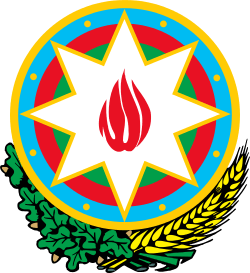Azerbaijani Community of Nagorno-Karabakh
| Dağlıq Qarabağın Azərbaycanlı İcması | |
|
Coat of Arms of Azerbaijan | |
| Agency overview | |
|---|---|
| Formed | March 24, 1992 |
| Headquarters | Baku, Azerbaijan Republic |
| Agency executives |
|
| Website | http://www.karabakh.az |
The Azerbaijani Community of Nagorno-Karabakh (Azerbaijani: Dağlıq Qarabağın Azərbaycanlı İcması), also known as the Azerbaijani Community of Nagorno-Karabakh Social Union and the Azerbaijani Community of Nagorno-Karabakh in exile, is a social union representing the Azerbaijani community of Nagorno (Upper) Karabakh, in exile since May 1994.
History
Its first elected leader was Nizami Bahmanov who was appointed the Head of Executive Power of Shusha on April 8, 1992.[1] Since Shusha was the only city in Nagorno-Karabakh with a majority Azerbaijani population, its executive officer was chosen to represent the whole Azerbaijani community of Karabakh. Bahmanov subsequently represented the Azerbaijani community of Nagorno-Karabakh region in peace talks held by the OSCE Minsk Group.
The status of the Azerbaijani Community of Nagorno-Karabakh Social Union, co-founded by Nizami Bahmanov, member of Azerbaijani Parliament, Havva Mammadova and Elman Mammadov, was formally confirmed by the Ministry of Justice of Azerbaijan in September 2006.[2][3]
Bahmanov died on September 13, 2008 while holding a meeting in his office.[4] The office of the leader of Azerbaijani Community of Nagorno-Karabakh remained unoccupied until February 27, 2009 when Bayram Safarov was appointed the Head of Executive Power of Shusha, subsequently filling the office of leader of Azerbaijani Community of Nagorno-Karabakh.[2][5] The name of the organization was changed to Azerbaijani Community of Nagorno-Karabakh Social Union on June 5, 2010.[2][3]
Structure
The union is a non-governmental organization, gaining no financial profit and based on volunteer membership. Its activities cover the whole territory of Azerbaijan Republic. The union's main purpose is the restoration of the territorial integrity of the Azerbaijan Republic and the return of Azerbaijani IDPs from Karabakh to their homes.
The organization therefore encourages more activities among the internally displaced population from Karabakh within the framework of the Azerbaijan-Armenia conflict; promotes education on the history and culture of Karabakh region; learns and offers solutions to problems of the community; stimulates education of members of the community abroad; promotes sports within the community; disseminates information about the willingness of the Azerbaijani community of Karabakh for peaceful resolution and the subsequent return of ethnic Azerbaijanis to Karabakh to the international community; and disseminates truth about the Karabakh conflict abroad.[3]
See also
- Refugees and internally displaced persons in Azerbaijan
- Shusha
- Nagorno-Karabakh
- Cabinet of Azerbaijan
External links
References
- ↑ "Nizami Bəhmənov iş otağında vəfat edib" [Nizami Bahmanov died in office]. Ria Information Agency. Retrieved 2010-11-26.
- 1 2 3 Javid Turan. "DAĞLIQ QARABAĞIN AZƏRBAYCANLI İCMASI YENİDƏN TƏŞKİLATLANIR" [Azerbaijani Community of Nagorno-Karabakh is being regrouped]. Yeni Musavat. Retrieved 2010-11-26.
- 1 2 3 ""DAĞLIQ QARABAĞ BÖLGƏSİNİN AZƏRBAYCANLI İCMASI" İCTİMAİ BİRLİYİNİN NİZAMNAMƏSİ" [Charter of the Azerbaijani Community of Nagorno-Karabakh region]. Media Forum. 2009-06-08. Retrieved 2010-11-26.
- ↑ Mahbube Gasimbeyli (2008-09-13). ""Dağlıq Qarabağın Azərbaycanlı İcması"nın rəhbəri Nizami Bəhmənov vəfat edib" [The leader of the Azerbaijani Community of Nagorno-Karabakh region passed away]. Azeri Press Agency. Retrieved 2010-11-26.
- ↑ Ilgar Rasul (2009-06-05). "Dağlıq Qarabağın Azərbaycanlı İcması özünə yeni rəhbər seçdi" [The Azerbaijani Community of Nagorno-Karabakh elected its leader]. RFE/RL. Retrieved 2010-11-26.
